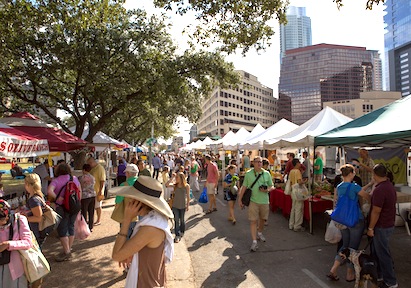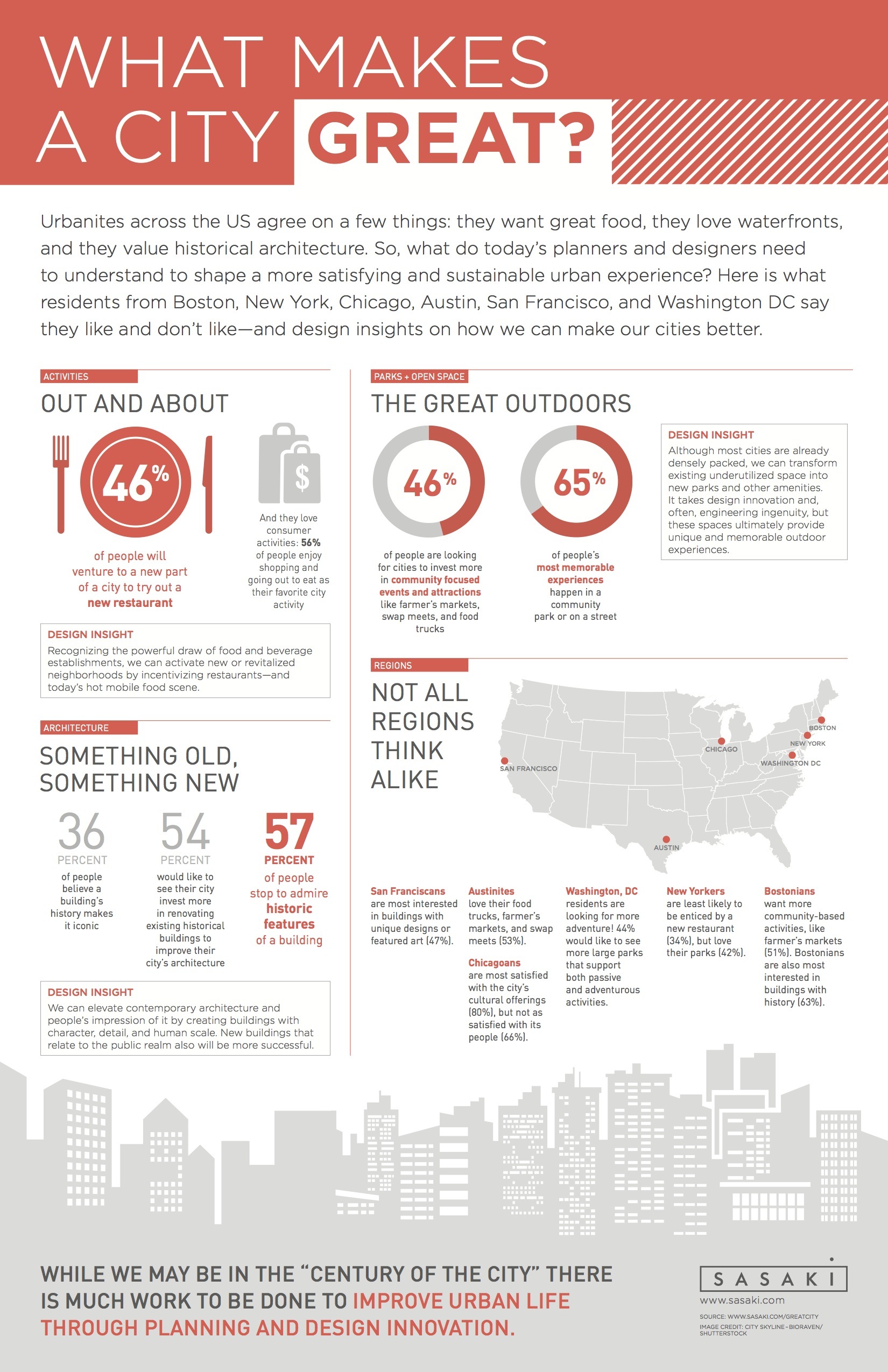A new study released by planning and design firm Sasaki Associates has found that food is a major driver of the American urban experience: 82 percent of urbanites appreciate their city’s culinary offerings, and a new restaurant is the top reason the majority of them (46 percent) would venture to a new part of their city. This is compared to 25 percent of people who are incentivized by a new store and 16 percent by a sporting event.
These preferences vary by region, however, with Bostonians most likely to be enticed by a new restaurant (59 percent) versus New Yorkers (34 percent), whose apparent abundance of choice ranked them lowest on this question. And the majority of people (41 percent) consider food and restaurants to be the most outstanding aspect of cities they love to visit.
Working with an independent research firm, Sasaki developed “The State of the City Experience,” which surveyed 1,000 people living and working in one of six cities: Boston, New York, San Francisco, Chicago, Austin, and Washington DC. The findings—and Sasaki’s insights—related to architecture, activities, parks, and transportation have major implications for cities, planners, and designers.
Beyond food, respondents also enjoy consumer activities such as shopping and going out to eat (56 percent) the most, followed by programmed events such as farmer’s markets, outdoor concerts and food trucks (45 percent). And they want more: 46 percent of respondents said they want their cities to invest in more community-focused events and attractions such as farmer’s markets, swap meets, and food trucks for their open spaces.
As for buildings, people love historic structures. When asked what makes a building iconic, most said it was its history (36 percent). And when walking along a downtown street, most people will stop to admire buildings that are historic (57 percent), versus those featuring public art, modern design, or their city’s tallest buildings.Regionally, Bostonians are the biggest admirers of historic buildings (63 percent), while San Franciscans are more likely to be attracted to buildings that prominently feature public art or very unique design elements (47 percent). Residents of Chicago, which has the nation’s tallest building, are more likely to admire skyscrapers (23 percent).
To improve their city’s architectural character, more than half of respondents (54 percent) would like to see their city renovating historical buildings, compared with22 percent who would like more unusual architecture.
“While those surveyed were unimpressed with modern architecture, we believe it is because today’s contemporary buildings tend to prioritize quantity and speed over quality and mission,” said Sasaki principal Victor Vizgaitis, AIA. “As planners and designers, our job is to understand what people want and balance these desires with the big picture—economic realities, cultural needs, environmental concerns, and design opportunities—ultimately helping to shape a more satisfying and sustainable urban experience.”
When it comes to the built environment, shared public spaces rule the day. Most people remember their favorite city experience taking place in a park or on a street (65 percent) compared to just 22 percent who said that special moment occurred in a private building. This is especially true among New Yorkers.
Reflecting a national trend of cities reclaiming their waterfronts, areas along rivers, lakes, or the ocean are the most popular open spaces across the country (47 percent) compared to 14 percent who prefer small urban parks or 8 percent who like their city’s trail systems.
So, what do Americans hate the most about their cities? Traffic. Overall, 41 percent percent say it’s what frustrates them the most, followed by not enough parking (23 percent) and poor public transportation (14 percent). This provides great opportunity for new technologies to rethink how vehicles can be used more effectively by urbanites, both in terms of commuting and sustainability.
Despite transportation frustrations, 60 percent of city dwellers plan to stay put in the next five years, either living where they do now or in a different part of the city.
The infographic below summarizes key findings. For the full report: www.sasaki.com/greatcity
Methodology
Sasaki commissioned independent research firm Equation Research to survey 1,000 people who live across six cities: Austin, Boston, Chicago, New York, San Francisco, and Washington DC. The study was conducted in May 2014.
About Sasaki
Collaboration is one of today's biggest buzzwords—but at Sasaki, it's at the core of what we do. We see it not just as a working style, but as one of the fundamentals of innovation. Our practice comprises architecture, interior design, planning, urban design, landscape architecture, graphic design, and civil engineering, as well as financial planning and software development. Among these disciplines, we collaborate in equilibrium. From our headquarters in Watertown, Massachusetts, we work locally, nationally, and globally. For more information about Sasaki, please visit: http://www.sasaki.com.
Related Stories
K-12 Schools | Aug 8, 2024
New K-12 STEM center hosts robotics learning, competitions in Houston suburb
A new K-12 STEM Center in a Houston suburb is the venue for robotics learning and competitions along with education about other STEM subjects. An unused storage building was transformed into a lively space for students to immerse themselves in STEM subjects. Located in Texas City, the ISD Marathon STEM and Robotics Center is the first of its kind in the district.
Affordable Housing | Aug 7, 2024
The future of affordable housing may be modular, AI-driven, and made of mushrooms
Demolished in 1989, The Phoenix Ironworks Steel Factory left a five-acre hole in West Oakland, Calif. After sitting vacant for nearly three decades, the site will soon become utilized again in the form of 316 affordable housing units.
Architects | Aug 5, 2024
Mastering the art of project schedule: Expert insights on design and construction
We sat down with two experts in the design field, Ron Dick (Founding Partner and Architect) and Mike Niezer (COO and Architect), to talk about everything you need to know about the entire process.
University Buildings | Aug 1, 2024
UC Riverside’s student health center provides an environment on par with major medical centers
The University of California, Riverside's new Student Health and Counseling Center (SHCC) provides a holistic approach to wellness for students throughout the UC Riverside campus. Designed by HGA and delivered through a design-build partnership with Turner Construction Company, SHCC provides healthcare offerings in an environment on par with major medical centers.
Libraries | Aug 1, 2024
How current and future trends are shaping the libraries of tomorrow
Over the last few years, public libraries have transitioned from being buildings that only store and lend books to being fully featured community centers.
MFPRO+ News | Aug 1, 2024
Canada tries massive incentive program to spur new multifamily housing construction
Canada has taken the unprecedented step of offering billions in infrastructure funds to communities in return for eliminating single-family housing zoning.
Government Buildings | Aug 1, 2024
One of the country’s first all-electric fire stations will use no outside energy sources
Charlotte, N.C.’s new Fire Station #30 will be one of the country’s first all-electric fire stations, using no outside energy sources other than diesel fuel for one or two of the fire trucks. Multiple energy sources will power the station, including solar roof panels and geothermal wells. The two-story building features three truck bays, two fire poles, dispatch area, contamination room, and gear storage.
Contractors | Aug 1, 2024
Nonresidential construction spending decreased 0.2% in June
National nonresidential construction spending declined 0.2% in June, according to an Associated Builders and Contractors analysis of data published today by the U.S. Census Bureau. On a seasonally adjusted annualized basis, nonresidential spending totaled $1.21 trillion. Nonresidential construction has expanded 5.3% from a year ago.
Student Housing | Jul 31, 2024
The University of Michigan addresses a decades-long student housing shortage with a new housing-dining facility
The University of Michigan has faced a decades-long shortage of on-campus student housing. In a couple of years, the situation should significantly improve with the addition of a new residential community on Central Campus in Ann Arbor, Mich. The University of Michigan has engaged American Campus Communities in a public-private partnership to lead the development of the environmentally sustainable living-learning student community.
MFPRO+ New Projects | Jul 31, 2024
Shipping containers converted into attractive, affordable multifamily housing in L.A.
In the Watts neighborhood in Los Angeles, a new affordable multifamily housing project using shipping containers resulted in 24 micro-units for formerly unhoused residents. The containers were acquired from a nearby port and converted into housing units at a factory.


















